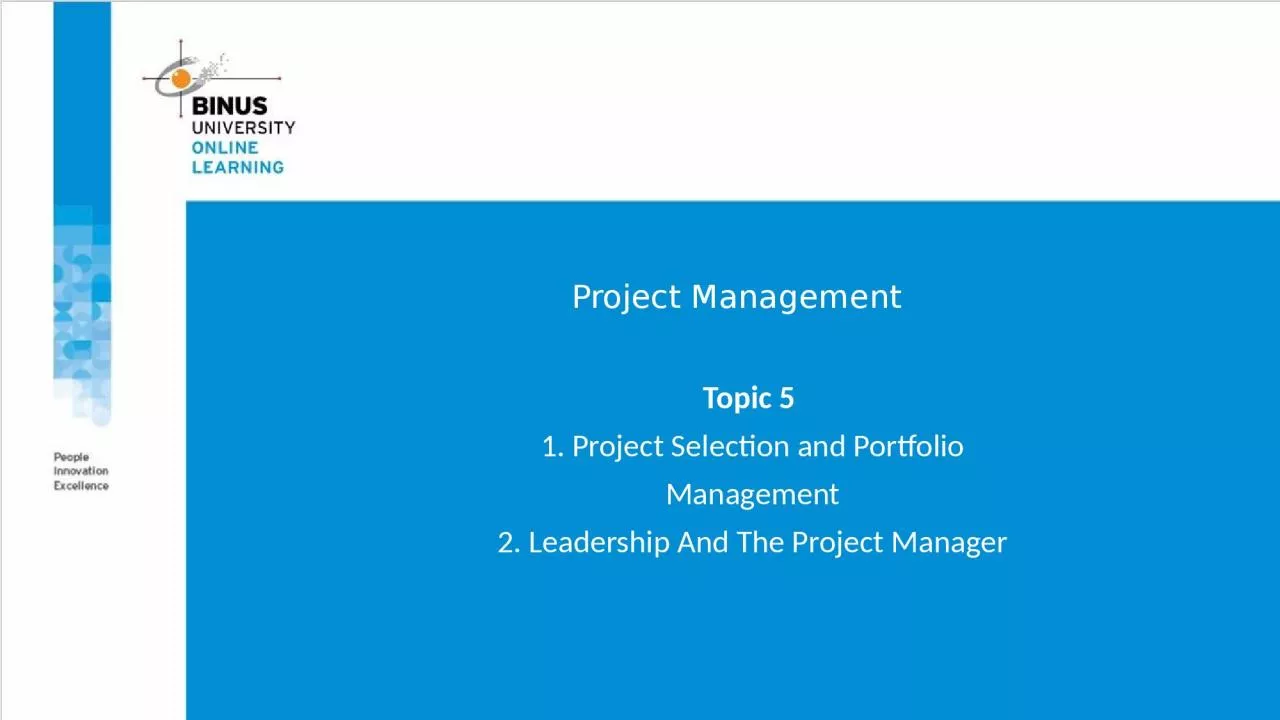

1 Project Selection and Portfolio Management 2 Leadership And The Project Manager LEARNING OUTCOMES After completing this chapter you should be able to Explain six criteria for a useful project selection screening model ID: 1028182
Download Presentation The PPT/PDF document "Project Management Topic 5" is the property of its rightful owner. Permission is granted to download and print the materials on this web site for personal, non-commercial use only, and to display it on your personal computer provided you do not modify the materials and that you retain all copyright notices contained in the materials. By downloading content from our website, you accept the terms of this agreement.
1. Project ManagementTopic 5 1. Project Selection and PortfolioManagement2. Leadership And The Project Manager
2. LEARNING OUTCOMESAfter completing this chapter, you should be able to:Explain six criteria for a useful project selection/ screening model.Learn how to use financial concepts, such as the efficient frontier and risk/return models.Identify the elements in the project portfolio selection process and discuss how they work in a logical sequence to maximize a portfolio.Understand how project management is a “leader-intensive” profession.Distinguish between the role of a manager and the characteristics of a leader.Understand the key behaviors in which project leaders engage to support their
3. OutlineProject Selection Approaches to Project Screening and SelectionFinancial ModelsProject Portfolio Management Leadership vs managerHow the Project Manager LeadsTraits of Effective Project LeadersProject ChampionsThe New Project LeadershipProject Management Professionalism
4. Project Selection
5. Screening ModelsScreening models help managers pick winners from a pool of projects.
6. Approaches to Project Screening and Selection
7. Method of Selection
8. Financial Models
9. Net Present Value Projects the change in the firm’s stock value if a project is undertaken.Higher NPV values are better
10. Discounted Payback Period The discounted payback period is a measure of how long it takes until the cumulated discounted net cash flows offset the initial investment in an asset or a project.Formula : DPP = y + abs(n) / p,wherey = the period preceding the period in which the cumulative cash flow turns positive,p = discounted value of the cash flow of the period in which the cumulative cash flow is => 0,abs(n) = absolute value of the cumulative discounted cash flow in period y.
11. Internal Rate of ReturnA project must meet a minimum rate of return before it is worthy of consideration.whereACFt = annual after-tax cash flow for time period tIO = initial cash outlayn = project’s expected lifeIRR = project’s internal rate of returnHigher IRR values are better!
12. exampleSuppose that a project required an initial cash investment of $5,000 and was expected to generate inflows of $2,500, $2,000, and $2,000 for the next three years. Further, assume that our company’s required rate of return for new projects is 10%. The question is, is this project worth funding?
13. exampleCash investment = $5,000Year 1 inflow = $2,500Year 2 inflow = $2,000Year 3 inflow = $2,000Required rate of return = 10%Step One: Try 12%.Decision: Present value difference at 12% is 250.50, which is too high. Try a higher discount rate.
14. exampleStep Two: Try 15%.Decision: Present value difference at 15% is $3, which suggests that 15% is a close approximation of the IRR.
15. Project Portfolio Management
16. Project Portfolio ManagementThe systematic process of selecting, supporting, and managing the firm’s collection of projects.Project portfolio management should have four goals: maximizing the value of the portfolio—the goal is to ensure that the total worth of projects in the pipeline yields maximum value to the company, achieving the right balance of projects in the portfolio—there should be a balance between high-risk and low-risk, short-term and long-term, genuine new products and product improvement projects, achieving a strategically-aligned portfolio—leading companies have a clear product innovation strategy that directs their R&D project investments, resource balancing—having the right number of projects in the portfolio is critical
17. Objectives And InitiativesPortfolio management, therefore, entails decision making, prioritization, review, realignment, and reprioritization of a firm’s projects
18. Developing A Proactive PortfolioThree factors determined that successfully managed project portfolios : Flexible structure and freedom of communicationLow-cost environmental scanningTime-paced transition
19. Leaders Versus Managers
20. LeadershipLeadership is a difficult concept to examine because we all have our own definition of leadership, our own examples of leaders in action, and our own beliefs about what makes leaders work.Project management has been viewed as one of the most leader-intensive undertakings within an organization.
21. Partnership IdeaFour things are necessary to promote the partnership idea between the project manager and the team:Exchange of purposeA right to say noJoint accountabilityAbsolute honesty
22. Leaders Versus Managers
23. How the Project Manager Leads
24. How the Project ManagerAcquiring Project ResourcesMotivating and Building TeamsHaving a Vision and Fighting FiresCommunicating
25. Traits of Effective Project Leaders
26. Five Characteristics Closely AssociatedFive characteristics closely associated with effective project team leaders:Credibility Creative problem-solverTolerance for ambiguity Flexible management style Effective communication skills
27. Project Champions
28. How To Make A ChampionIdentify And Encourage The Emergence Of ChampionsEncourage And Reward Risk TakersRemember That Champions Are Connected Emotionally To Their ProjectsDon’t Tie Champions Too Tightly To Traditional Project Management DutieS
29. The New Project Leadership
30. Four competenciesFour competencies that determine our success as project leadersThe new leader understands and practices the power of appreciation. These project leaders are connoisseurs of talent, more curators than creatorsThe new leader keeps reminding people of what’s importantThe new leader generates and sustains trustThe new leader and the led are intimate allies
31. Project Management Professionalism
32. ProfessionalismGrowing professionalism of the project management disciplineFirst, for more and more organizations, project work is becoming the standardSecond, there is a critical need to upgrade the skills of those doing project workThird, project management professionalism recognizes the need to create a clear career path for those who serve as project managers and support personnel
33. ReferenceJeffrey Pinto, 2021, Project Management Achieving Competitive Advantage, Fifth Edition, Pearson Education Limited, United Kingdom, ISBN 978-1-292-26914-6. Chapter 3 and 4
34.